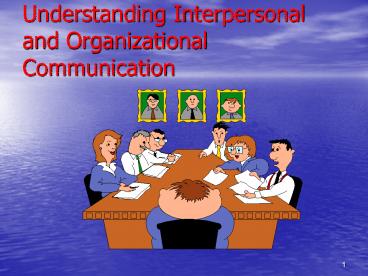Understanding Interpersonal and Organizational Communication - PowerPoint PPT Presentation
Title:
Understanding Interpersonal and Organizational Communication
Description:
Title: Organizational Communication Upward Communication Author: maamodt Last modified by: HP Authorized Customer Created Date: 7/12/1999 8:49:48 PM – PowerPoint PPT presentation
Number of Views:207
Avg rating:3.0/5.0
Title: Understanding Interpersonal and Organizational Communication
1
Understanding Interpersonal and Organizational
Communication
2
Organizational CommunicationUpward Communication
- Serial communication
- MUM effect
- open-door policy
- Attitude survey
- Suggestion box
- Liaison
3
Organizational CommunicationDownward
Communication
- Meetings
- Memo
- Phone call
- Bulletin board
- Employee handbook
- Intranet
4
Organizational CommunicationHorizontal
Communication
- Grapevine
- single-strand pattern
- gossip pattern
- probability pattern
- cluster pattern
- Rumor
5
Problem Area IIntended Message Versus Message
Sent
- Think about what you want to communicate
- Practice what you want to communicate
- Learn better communication skills
6
Problem Area IIMessage Sent Versus Message
Received
- Actual words used
- Communication channel
- Noise
- Nonverbal cues
- Paralanguage
- Artifacts
- Amount of information
7
Actual Words Used
- The word fine
- to describe jewelry
- to describe the weather
- to describe food or sex
- The applicant was a
- female
- girl
- babe
- woman
8
Use concrete words and ask how the other person
might interpret your message
- Avoid such words as
- as soon as possible
- Ill be back soon
- Ill be out for a while
- Why not be specific?
- Avoid confrontation
- test the water
- Avoid being the bad guy (MUM effect)
9
Gender Differences in Communication(Tannen, 1986
1990)
- Men
- Talk about major events
- Tell the main point
- Are more direct
- Use uh-huh to agree
- Are comfortable with silence
- Concentrate on the words spoken
- Sidetrack unpleasant topics
- Women
- Talk about daily life
- Provide details
- Are more indirect
- Use uh-huh to listen
- Are less comfortable with silence
- Concentrate on nonverbal cues and paralanguage
- Focus on unpleasant topics
10
Communication Channels
- Oral
- in-person
- word-of-mouth
- answering machine
- Nonverbal
- Written
- personal letter/memo
- general letter/memo
11
Noise
- Actual noise
- Appropriateness of the channel
- Bias
- Feelings about the person communicating
- Mood
- Perceived motives
12
Nonverbal Cues
- Are ambiguous
- Those that arent, are called emblems
- Gender and cultural differences are common
- Nonverbal cues are thought to be 80 of the
message received
13
Nonverbal Cues Include
- Eye contact
- Expressions
- Micro-expressions
- Posture
- Arm and leg use
- Motion
- Touching
14
Use of Space
- Intimacy zone
- 0 to 18 inches
- close relationships
- Personal distance zone
- 18 inches to 4 feet
- friends and acquaintances
- Social distance zone
- 4 to 12 feet
- business contacts and strangers
- Public distance zone
- 12 to 25 feet
15
Use of Time
- Being late
- Leaving a meeting early
- Setting aside time for a meeting
- Multi-tasking (working while talking)
16
Basic Assumptions About Nonverbal Cues
Paralanguage
- People are different in their use of nonverbal
cues and paralanguage - Standard differences among people reveal
information about the person - Changes in a persons style reveal new messages
17
Paralanguage
- Rate of speech
- Loudness
- Intonation
- Amount of talking
- Voice pitch
- Pauses
18
The Importance of Inflection
- I did not say Bill stole your car.
- I did not say Bill store your car.
- I did not say Bill stole your car.
- I did not say Bill stole your car.
- I did not say Bill stole your car.
- I did not say Bill stole your car.
- I did not say Bill stole your car.
19
Artifacts
- Our office
- décor
- desk placement
- What we wear
- clothing
- accessories
- hair styles
- tattoos
- The car we drive
- The house we live in
20
The Amount of InformationWhen we have too much
information, we tend to
- Assimilate
- Sharpen
- Level
21
The Amount of InformationReactions to
Information Overload
- Omission
- Error
- Queuing
- Escape
- Use of a gatekeeper
- Use of multiple channels
22
Problem Area IIIMessage Received Versus Message
Interpreted
- Listening Skills
- Listening Style
- Emotional State
- Cognitive Ability
- Bias
23
The Importance of Listening
- 70 of a managers job is spent communicating
- Of that time
- 9 is spent writing
- 16 is spent reading
- 30 is spent speaking
- 45 is spent listening
24
Listening Skills
- Stop talking and listen
- Show the speaker you want to listen
- Empathize with the speaker
- Dont ask excessive questions
- Remove distractions
- Keep an open mind
- Use appropriate nonverbal cues
- Let the other person finish speaking
- Try to understand what the other person means
25
Listening Styles(Geier Downey, 1980)
- Leisure
- Inclusive
- Stylistic
- Technical
- Empathic
- Nonconforming
26
Other Factors
- Emotional State
- Anger
- Fear
- Anxiety
- Excitement
- Love
- Bias
- Cognitive Ability
- Drugs and Alcohol
27
Writing is easiest to read when it
- has short sentences
- uses simple rather than complicated words
- uses common rather than unusual words































